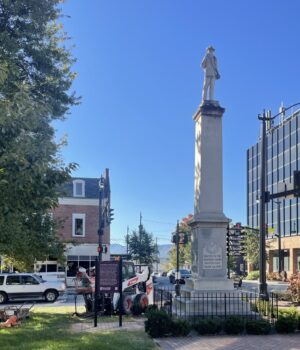Over fall break, Roanoke College put up a sign next to the Confederate statue on the corner of West Hall explaining the ownership of the monument and the inability of the college to remove it despite student and faculty interests. Roanoke College bought West Hall from Roanoke County in 1987, but Roanoke County kept ownership of the small square of land the statue sits upon. The monument was erected in 1909 by Southern Cross Chapter U.D.C. The base of the monument is inscribed “In memory of the Confederate soldiers of Roanoke County 1861—1865… Love makes memory eternal” and the monument itself depicts a confederate soldier. The College has been battling Roanoke County for decades asking permission to remove or relocate the confederate statue to elsewhere. During the time Michael Maxey was President, this movement, titled the “Not Our Monument Project” gained momentum. The college allegedly offered to pay for removal of the statue, but Roanoke County declined. The Center for Studying Structures of Race at Roanoke College has continued fighting for removal and allowing students, faculty, and staff a place to voice concerns.
Now, Roanoke College sits at the intersection of a national movement renouncing the honoring of confederate soldiers and generals. Unlike most schools tasked with dealing with these statues, however, Roanoke does not own the land or statue and has no legal right to move it. Even though the statue sits right outside of West Hall and is often thought to be a part of campus, it is not owned by Roanoke College. To combat any misunderstandings about the nature of the statue, the College erected a sign over fall break explaining the history of the land and statue. The last two lines of this sign show the college’s stance on this issue. They are “Roanoke County’s monument connects us to a past that will not be a part of our future. This is not our monument.”
Removing Confederate Statues is controversial and hard to pull off without serious backlash. Some people view the Civil War and the Confederacy as a part of history which should be honored and memorialized. Some view it as a tragic part of our history, which matters but should not be commemorated or celebrated. Virginia law details how to remove or relocate these statues, but it is a complicated process which requires citizens approval. This would also have to be initiated by the entity that owns the property, which is Roanoke County. This is not our monument, this is not our legacy, and this is not our future.
Mikaela Gantz
Editor-in-Chief




